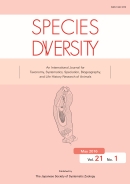Volume 14, Issue 1
Displaying 1-7 of 7 articles from this issue
- |<
- <
- 1
- >
- >|
-
Article type: Article
2009Volume 14Issue 1 Pages 1-8
Published: April 30, 2009
Released on J-STAGE: March 30, 2018
Download PDF (846K) -
Article type: Article
2009Volume 14Issue 1 Pages 9-14
Published: April 30, 2009
Released on J-STAGE: March 30, 2018
Download PDF (433K) -
Article type: Article
2009Volume 14Issue 1 Pages 15-25
Published: April 30, 2009
Released on J-STAGE: March 30, 2018
Download PDF (799K) -
Article type: Article
2009Volume 14Issue 1 Pages 27-39
Published: April 30, 2009
Released on J-STAGE: March 30, 2018
Download PDF (2149K) -
Article type: Article
2009Volume 14Issue 1 Pages 41-47
Published: April 30, 2009
Released on J-STAGE: March 30, 2018
Download PDF (500K) -
Article type: Article
2009Volume 14Issue 1 Pages 49-59
Published: April 30, 2009
Released on J-STAGE: March 30, 2018
Download PDF (804K) -
Article type: Article
2009Volume 14Issue 1 Pages 61-67
Published: April 30, 2009
Released on J-STAGE: March 30, 2018
Download PDF (3070K)
- |<
- <
- 1
- >
- >|
